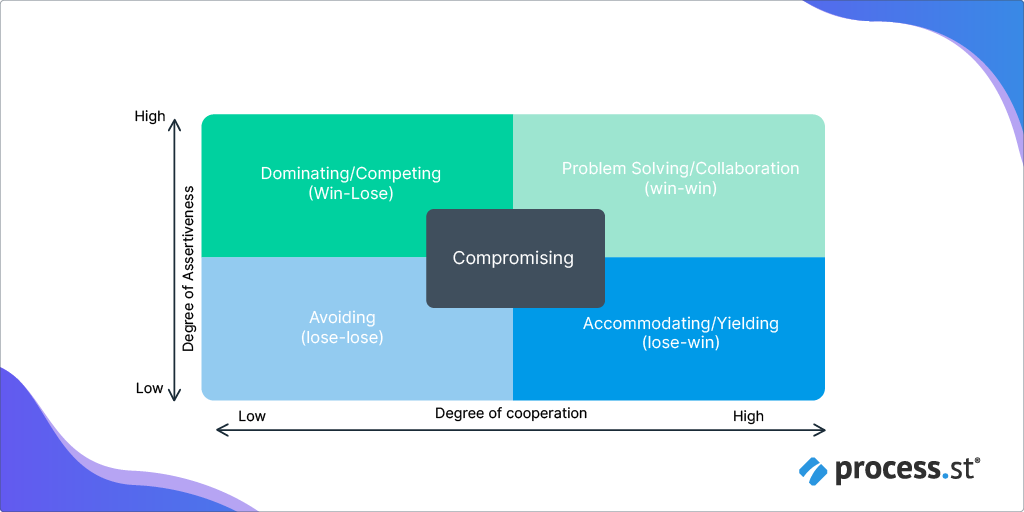
This is a guest post from Olivia Harp, whose easy-reading, approachable pieces help bring important business and negotiation skill-building content to new audiences in an accessible way. With a degree in linguistics, Olivia excels in creating her own engaging content.
Sustaining customer satisfaction can be challenging in business. However, there are several ways to improve your sales and customer satisfaction at the same time. Improving your sales negotiation skills is an overlooked low-hanging fruit route to making a positive impact on your customer relations.
Through sales negotiation training, you can learn how to identify your customer needs better. Understanding your customers puts you in a position to offer better services. By improving your customer relations, you may be able to attract and retain more customers.
This article outlines practical negotiation tips to increase your customers’ satisfaction.
In this Process Street article, we’ll cover:
- Redefine your business strategy
- Analyze your sales negotiation tactics
- Review your negotiation style
- Additional negotiation skills for customer satisfaction
- Get it right every time with Process Street
Redefine your business strategy
A clear business strategy makes sure that your team members are on the same page. Working together towards common goals can strengthen your team dynamics. Also, your harmony can build customers’ trust.
Several studies show that customer trust is essential when building customer loyalty.
Consider using customer retention strategies in your plan when redefining your strategy. According to the Harvard Business Review, your profits can improve by 25% to 95% if you increase customer retention by 5%.
If your customers keep coming back to buy from you, it can be a strong indicator that they are happy with your services. Also, it generally costs less to retain existing customers than to acquire new ones.
Analyze your sales negotiation tactics
When negotiating with your customers, you can go for a hard or a soft-selling approach. Your choice depends on several factors such as type of product and sales priorities. Sales negotiation training can teach you when to use the hard or soft-selling approach.
The hard selling negotiation tactic
Hard selling uses a direct approach to sales negotiation and is also known as high-pressure selling. Hard selling is straightforward and focuses on informing the customer of the benefits of buying your product or service. It is commonly used for door-to-door sales and cold calls.
You can use the hard-selling approach when making one-time sales or dealing with quick-moving products. Customers who need help deciding on a certain product can appreciate this approach. If used in the wrong way, hard selling can drive away your customers.
However, sales training classes can teach you how to attract customers using hard-selling techniques. The following are ideas you can use to improve a customer’s experience when hard selling:
- Honesty
- Relevance
- Business etiquette
- Value addition
Honesty: You can lose valuable deals if your customer catches you in a lie. Mahatma Gandhi once said that the moment there is suspicion about a person’s motives, everything he does becomes tainted. You can gain your customers’ respect by being honest about a new product’s pros and cons. Your honesty can make you stand out among other negotiators and attract customers to you.
Relevance: Hard selling can overwhelm your customer with too much information. Negotiation training can teach you how to identify your customers’ needs easily. This can help you to present relevant benefits that can guide your customers’ decisions.
Business etiquette: Hard-selling techniques are direct and can be perceived as aggressive. Lack of business etiquette can drive away customers. Negotiation trainers can teach your team how to maintain a respectful attitude even when the customer is misbehaving. Business etiquette can be a valuable skill when dealing with a tough customer.
Value addition: Hard selling is often accompanied by discount offers for time-sensitive deals. You can drive customer satisfaction by offering valuable deals. While offering discounts can reduce your margins, the aim, of course, is to generate more revenue. Sales trainees should learn how to devise the best negotiation strategies in varying situations.
The soft selling negotiation tactic
Soft selling is geared towards guiding rather than pushing your customers to a decision. It’s a more subtle, persuasive, or indirect style of selling. In soft-selling negotiations, you can talk to your customers in a more friendly yet convincing tone.
Many large companies use the soft-selling approach to build brand and customer loyalty. This approach works well when forging long-term relationships with valued customers. Soft selling is suitable when making complex sales such as professional services where customer trust is vital.
Sales trainers typically use practical role-play sessions to improve soft-selling skills. The list below highlights some popular soft-selling tactics:
- Free trials
- Informative videos
- Social media
Free trials: Many Software as a Service (SaaS) companies can offer free 14 or 30-day trials. Customers can learn to use the software before making a financial commitment.
Informative videos: Many companies produce YouTube tutorials and promotional videos to indirectly present the benefits of their products. This is an effective method to build customer trust.
Social media: Many companies post blogs and articles on social media to attract new customers. You can also use platforms like Facebook and LinkedIn to talk to your existing customers and offer support services.
Review your negotiation style

There are five main negotiation styles used in business. Each style has pros and cons in varying situations. Many business people tend to use only one or two negotiation styles. However, skilled negotiators switch between all five.
You can train your employees on how to use the five negotiation styles in varying sales situations. It is important to note that your customers may use different negotiation styles as well. Negotiation trainers can simulate real-world scenarios to teach you better ways to talk with your customers. If you understand your customers, you can offer them better services.
The five negotiation styles are:
- Avoid (I lose – You lose)
- Accommodate (I lose – You Win)
- Compete (I Win – You Lose)
- Compromise (I lose/win some – You lose/win some)
- Collaborate (I Win – You Win)
Avoid (I lose/You lose)
Avoiding is a style of negotiation where both you and your customer lose something. It is a style that seeks to end the confrontation at any cost. The “avoiding” stance is typically taken by people who don’t like conflict.
Also, customers who are not ready to make a purchase may use the avoiding style. It is best to be considerate with customers who use this style as they can be intimidated more easily.
Accommodate (I lose – You Win)
The accommodating style can be used by customers who want to support your business. These customers are typically more interested in the relationship than the deal at hand. This style can be used by friends, relatives, and people who admire you. If you are not careful in these kinds of dealings, you could do lasting damage to a valuable relationship. You should be careful not to take advantage of a customer using this negotiating style.
If you consider using this style as a seller, it could mean unnecessarily offering discounts to accommodate a customer. You can also offer better payment terms or after-sales support such as delivery and installation. This style can be useful when developing new business relationships.
However, you need to be clear about how much you are willing to lose. If you are not well prepared when using the accommodating style, you could end up with a huge loss.
Compete (I Win – You Lose)
The competing negotiation style is used when you want to win and don’t care much for how the other side fares. As a salesperson, you could easily trigger offense in some customers when using this style of negotiation. If you must use this style, you should learn how to be respectful and keep your temper in check.
Using the competing style is also an easy way to drive away customers. You can use this style if you have a decisive advantage and have calculated that your customer has no other option.
You can also compete when your back is against the wall and are making deals that you cannot afford to compromise on. With proper training, you can learn how to counter the competing style when customers compete with you.
Compromise (I lose/win some – You lose/win some)
A compromising negotiation seeks to find a common ground between you and your customer. This negotiation style depends on making concessions. Both you and your customer should be willing to meet somewhere in the middle. The compromising style may get engagement from customers who have disengaged and so are using an avoiding negotiation style.
You can more safely use the compromising negotiation style when dealing with a customer you know and trust. Finding a balance that suits you and your customer can strengthen your relationship. You can also use this style when trading in items that you are comfortable making concessions on.
The compromising style can be challenging if your negotiation strategy does not have room for concessions. In sales, concessions don’t have to mean reductions in price. Your concessions can be better payment terms or credit extensions.
Negotiation trainers can teach you how to come up with suitable concessions in various types of deals. The compromising style can work well where a relationship of trust exists.
Collaborate (I Win – You Win)
Collaborating is often spoken of as the holy grail of negotiating styles—especially amongst sellers. Here, both you and your customer seek to maximize value in the final deal. If you seek win-win agreements, you are more likely to be building longer-term relationships with your customers.
However, mutually beneficial deals can be tough to design without proper training. If you plan to run your business with win-win collaborative customer relationships, you would be wise to develop your team’s soft business skills.
Your business marketing may benefit from collaborative deals. You can create value by giving away free branded merchandise with your sales. The merchandise can earn you free publicity while adding value to your customers.
Including collaborative deals as part of your marketing strategy can help to boost the visibility of your business.
Additional negotiation skills for customer satisfaction
There is a lot more you can do to create a lasting positive impression. The list below highlights a few negotiation training skills that can encourage your customers to keep buying from you:
- Active listening
- Patience
- Self-control
Negotiation skill #1: Active Listening
Active listening skills enable you to gather information that can improve your negotiating position. Many salespeople miss out on deals because they would rather talk than listen. Active listening enables you to understand your customers better.
Doing this also encourages customers to talk to you freely. Maintaining eye contact and mirroring gestures can make your customers more comfortable. Also, paraphrasing customers’ points for clarification can make them feel valued. According to Forbes Media, paraphrasing what you hear can give your customers a chance to clarify any confusion.
Negotiation skill #2: Patience
Patience is a valuable sales negotiation skill to master. You may need the patience to develop your customers’ trust. Trust is a key component of customer satisfaction.
In his book The Speed of Trust, Stephen Covey highlights the benefits of building a relationship of trust with your customers. According to Mr. Covey, “In a high-trust relationship, you can say the wrong thing, and people will still get your meaning. In a low-trust relationship, you can be very measured, even precise, and they’ll still misinterpret you.”
If you are well prepared, you can be patient with your customers during your discussions. In your preparations, work on creating enough time for uninterrupted meetings with your customers. It can be difficult to close a valuable deal if you are in a hurry.
Negotiation skill #3: Self-Control
It is important for a sales negotiator to have self-control. Acting frustrated when your customer is hesitant can sabotage your deal. If you are calm, you can turn your customer’s hesitation into a chance for value addition.
By remaining composed during the negotiations, you can win valuable customers over. If you find controlling your temper a challenge, you may consider taking anger management classes. Lack of self-control can destroy your relationships with customers.
Get it right every time with Process Street
Without proper training, your negotiation methods can hurt your customers. Your customers’ perceptions heavily weigh on the success of your business. That’s why it’s crucial to get it right every time.
To do this, you’ll need to deliver the right sales negotiation training and to have a solid set of processes to follow to maintain those successes.
This is where Process Street comes in.
Process Street for superpowered workflows
You determine the process to follow to undertake a task and then follow it via the workflow builder.
You can create workflow templates for managing processes with multiple stakeholders. Features like role assignments, conditional logic, and variables give you the powerful workflow features and capabilities necessary to drive complex scenarios forward with ease.
Process Street’s ability to integrate with thousands of other work apps also means that you can automate huge amounts of work. Let your salespeople focus on negotiating a sale rather than wasting their time with data entry, data management, and the rest of the paperwork duties.
Check out this BANT sales qualification process for qualifying new leads.
You could build your new sales negotiation skills into the BANT call to streamline your process.
Using Process Street can help you see the sustained results of improved sales training, sales processes, and sales team workflows.
Get started with Process Street for free today by signing up.
How do you approach negotiations in your business? What has worked well and what worked badly? Let us know all your best and worst stories in the comments!







 Workflows
Workflows Projects
Projects Data Sets
Data Sets Forms
Forms Pages
Pages Automations
Automations Analytics
Analytics Apps
Apps Integrations
Integrations
 Property management
Property management
 Human resources
Human resources
 Customer management
Customer management
 Information technology
Information technology




Adam Henshall
I manage the content for Process Street and dabble in other projects inc language exchange app Idyoma on the side. Living in Sevilla in the south of Spain, my current hobby is learning Spanish! @adam_h_h on Twitter. Subscribe to my email newsletter here on Substack: Trust The Process. Or come join the conversation on Reddit at r/ProcessManagement.